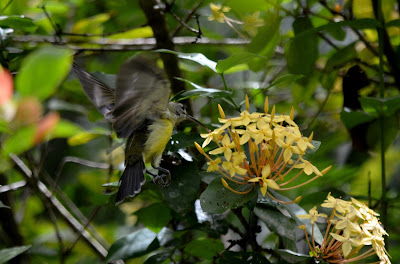Wednesday, July 31, 2013
Tuesday, July 30, 2013
Steps closer to nature
 |
| Steps at Heliconia Valley area, separating Zone C and D |
There is something energizing about walking the steps of nature. To be close to the earth and to stand barefooted on the jungle footpath. The earthing connection is immediately felt. Every step you make you feel alive and jumpy. Then you feel the awe and respect you forget to give Mother Nature.
 |
| Location: Heliconia Valley, between Zone C and D |
At Botanic Island One there are a series of these simple earthen steps that are built for the convenience of workers and visitors. They lead to rest areas, benches, stools or cut down logs for much needed respite and relaxation. I find abundant pleasure and deep-felt satisfaction sweeping these steps of fallen leaves and jungle litter. The rustling sound is instant therapy and its cracking noise quietened the chaos of the outside world. For once you are focussed with the love of nature and peace creeps in your tired mind. ...So, go and find steps closer to nature!
 |
| Botanic Island One steps, looking south |
 |
| Botanic island one, steps looking west |
 |
| Botanic Island One, steps looking west |
 |
| Botanic Island One, steps looking south |
Monday, July 29, 2013
Celebration of a century!
 |
| Agave americana marginata - Century plant location : Zone C, along the Eugenia trail |
Today calls for a celebration. The Century plant that I planted 8 years ago have finally flowered. The flowers are borne on a long solid pole or terminal shoot. This plant flowers only once at the end of their lives which may be between 5-35 years. I guess the plant would like to give a good Ramadhan surprise. Because the plant takes such a long time to flower - long enough to seem like a century, it is thus named the 'Century 'plant. Yahooo, thrilled indeed I was!
 | |
| The greenish yellow flowers face upwards, are lightly scented with two whorls and 6 petal-like tepals. |
 | |||
| Location: Zone C, along Eugenia trail The Agave americana marginata or Century plant terminal shoot is about 10 meters long and rises spectacularly from the centre of the rosette. |
The plant is 2 meters across and more than a human height i.e. about 7 feet high. The form I have here is the variegated type with creamish white margins. There are sharp spines along the margins . The dense crown of sword-like leaves have a dramatic effect and is used in many landscape treatments like rockeries or rock gardens. Once the flowering is over, the plant will form offsets or plantlets in the form of bubils alongside the flowers and I hope to collect the plantlets in the hundreds soon....
 |
| From a single long solid pole or flowering shoot, branched flower stems are produced bearing the hundreds of flowers and later the plantlets. |
Sunday, July 28, 2013
Botanic Island and walk
 |
| Botanic Walk One, between Island One at left and island Two at right. |
 |
| Fresh fruit bunch of the oil palm cut open |
 |
| Fresh fruit bunches of the oil palm eaten by squirrels.. Oil palm (Elaeis guineensis) |
 |
| Squirrel at Botanic Island One |
 |
| Botanic Walk Two , entering through the island of lianas and climbers |
 |
| Butterfly at Botanic Island Two. |
 |
| Red-headed (Ashy) Tailorbird (Orthotomus ruficeps) hunting for red ants.. location : Botanic Island Two |
 |
| Botanic Island Two, looking south |
 |
| Lianas or climbers reach to the top of some of the tall tropical hardwood trees at Botanic Island Two |
 |
| Botanic Walk Three...entering the rattan territory |
The rattans produce fruits that are eaten by many wild animals like the palm civet cat or what the locals here called "Musang". The prevalence of many wildlife will be rewarding for those interested in birdwatching and other wildlife subjects.
 |
| Fruits of the rattan location : Botanic Island Three |
 |
| Fungi at Botanic Island Three |
 |
| "Musang" or the palm civet cat |
Heliconia Valley and Footpath
 |
| Heliconia chartacea 'Sexy Pink', Heliconia Valley walk |
Here's some collection of heliconias at the Park. I have planned a special area to exhibit the heliconias called the Heliconia Valley. Heliconias are useful as cut flowers, besides being attractive to the birds. They are an ideal plant for the Kambatik garden (Malaysian garden) because they thrive in our tropical climate. furthermore they require minimum maintenance.
Checkout how I use them as cut flowers in the Kambatik-style floral arrangement here...>>>
| Heliconia caribaea |
 |
| H. rostrata |
 |
| H. latispatha |
 |
| Botanic Island One, Mid-hill footpath |
 |
| Botanic Island One, Mid-hill footpath |
 |
| Heliconia 'Golden Torch' |
 |
| Heliconia 'Lobster Claw' |
 |
| Heliconia pssitacorum (Parrot flower) |
 |
| Heliconia pssitacorum (Parrot flower) |
 |
| Heliconia pssitacorum (Parrot flower) |
 |
| Heliconia pssitacorum (Parrot flower) |
 |
| Heliconia pssitacorum (Parrot flower) |
Saturday, July 27, 2013
Birds of the Park - Little Spiderhunter
It amazes me why the Little Spiderhunter that comes regularly to the yellow Ixora coccinea flowers does not come in pairs. The Malays call it 'Kelicap Jantung' and it produces a nice 'chirp,chirp,chirp,chirp' notes. Besides preying on soft insects like ants and spiders, it loves to sip the nectar from the ixora flowers and in so doing does fine acrobatic show.
Here's more pics of the bird for the album.
Here's more pics of the bird for the album.
 | |||||||||||||||||
| Little Spiderhunter (Kelicap Jantung -Malay) Arachnothera longirostra Date taken : 28 Jul'13, location : Zone C |
Subscribe to:
Posts (Atom)















